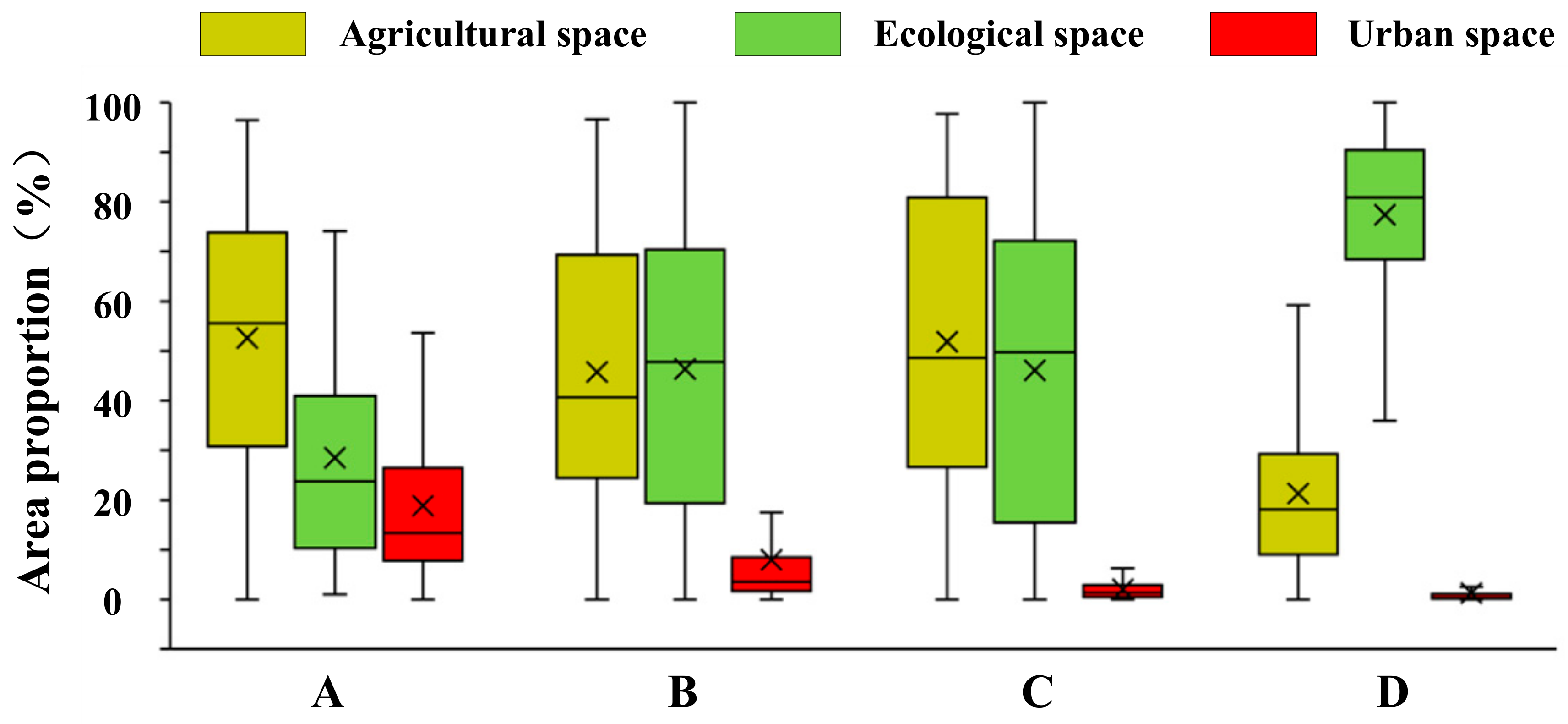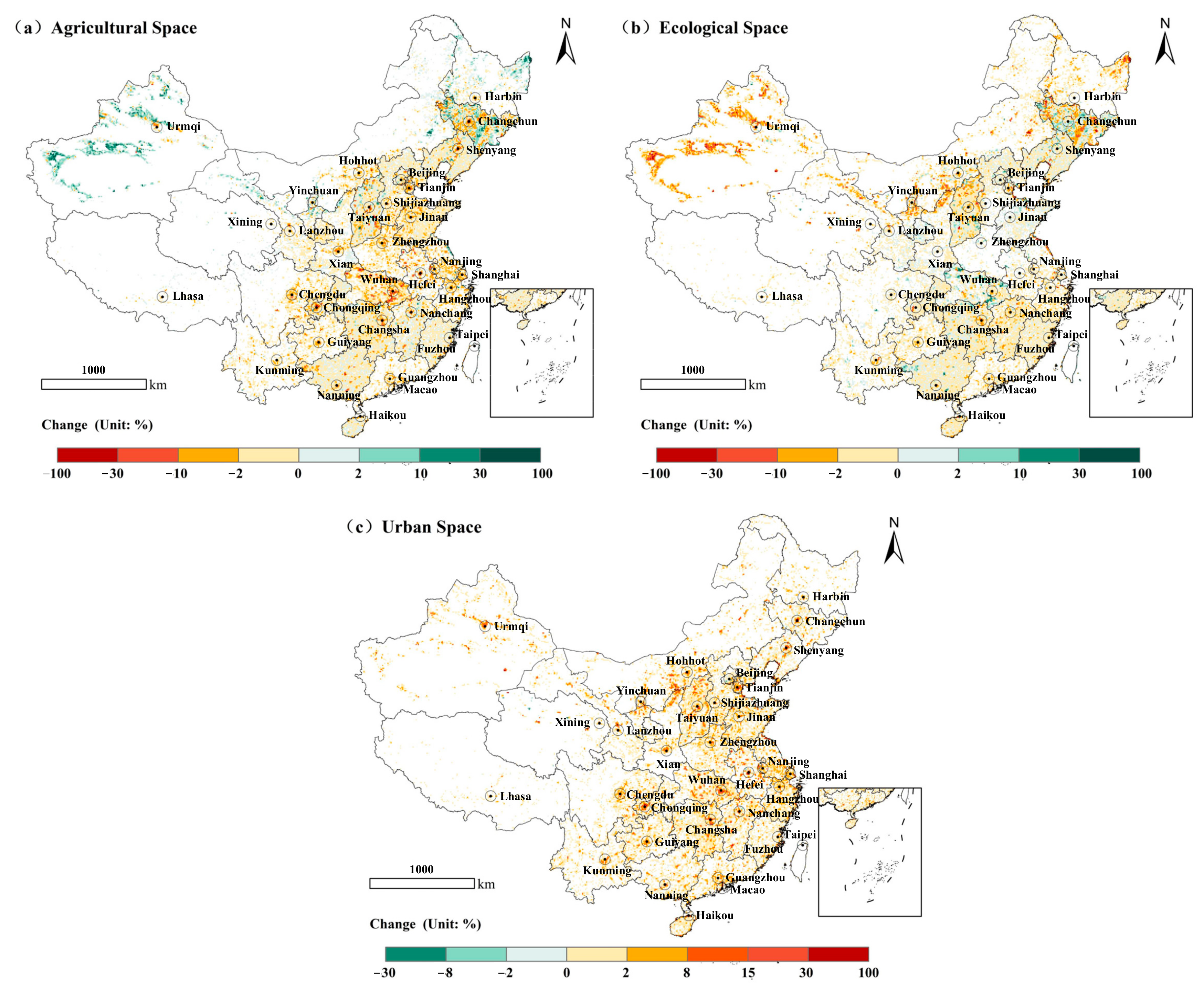Impact of Major Function-Oriented Zone Planning on Spatial and Temporal Evolution of “Three Zone Space” in China
Abstract
:1. Introduction
2. Data and Methods
2.1. Land Use Dataset
2.2. National Zoning Data of the Main Functional Areas
2.3. Classification System of the “Three Zone Space”
2.4. “Three Zone Space” Dynamic Degree
3. Results
3.1. Analysis of “Three Zone Space” Patterns in China in 2020
3.2. Spatial and Temporal Evolution Characteristics of the “Three Zone Space” from 2010 to 2020
3.3. Dynamic Evolution of the “Three Zone Space” in Each MFOZ from 2010 to 2020
4. Discussion and Conclusions
Author Contributions
Funding
Institutional Review Board Statement
Informed Consent Statement
Data Availability Statement
Conflicts of Interest
References
- Liu, H.; Gao, X.L.; Liu, S.H. The foreign territory development patterns and its inspirations. World Reg. Stud. 2008, 17, 38–46+37. [Google Scholar]
- Lovell, S.T. Multifunctional urban agriculture for sustainable land use planning in the United States. Sustainability 2010, 2, 2499–2522. [Google Scholar] [CrossRef]
- Fan, J.; Zhou, K.; Chen, D. Innovation and practice of economic geography for optimizing spatial development pattern in construction of ecological civilization. Econ. Geogr. 2013, 33, 1–8. [Google Scholar]
- Lambin, E.F.; Meyfroidt, P. Global land use change, economic globalization, and the looming land scarcity. Proc. Natl. Acad. Sci. USA 2011, 108, 3465–3472. [Google Scholar] [CrossRef] [PubMed]
- Kramer, D.B.; Hartter, J.; Boag, A.E.; Jain, M.; Stevens, K.; Nichoals, K.A.; McConnell, W.J.; Liu, J.G. Top 40 questions in coupled human and natural systems (CHANS) research. Ecol. Soc. 2017, 22, 44. [Google Scholar] [CrossRef]
- Liu, H.; Fan, J.; Li, Y. “America 2050” strategic spatial planning and its inspiration to China. Geogr. Res. 2013, 32, 90–98. [Google Scholar]
- Liu, J.Y.; Liu, W.C.; Kuang, W.H.; Ning, J. Remote sensing-based analysis of the spatiotemporal characteristics of built-up area across China based on the plan for major function-oriented zones. Acta Geogr. Sin. 2016, 71, 355–369. [Google Scholar]
- Song, R.; Hu, Y.C. Comprehensive zoning of land consolidation potential in cities of China and optimization pathways. J. Geo-Inf. Sci. 2020, 22, 1522–1531. [Google Scholar]
- Fan, J. Draft of major function oriented zoning of China. Acta Geogr. Sin. 2015, 70, 186–201. [Google Scholar]
- Chen, M.X.; Liang, L.W.; Wang, Z.B.; Zhang, W.Z.; Yu, J.H.; Liang, Y. Geographical thinking on the relationship between beautiful China and land spatial planning. Acta Geogr. Sin. 2019, 74, 2467–2481. [Google Scholar]
- Liu, J.H.; Zheng, X.Q. City-level main functional division based on improved ecological footprint model. Trans. Chin. Soc. Agric. Eng. 2013, 29, 226–236. [Google Scholar]
- Mao, J.X.; Li, Y.L.; Lu, X.X.; Liu, X.Y. Strategic transmission path of main functional areas in Nanning Territory Spatial Master Plan. Planners 2021, 37, 30–37. [Google Scholar]
- Yu, C.J.; Wang, Q. A study on the spatiotemporal pattern changes of “Agricultural-living & Non-agricultural production-ecological” in different major function-oriented zones of Fujian Province. J. Fujian Norm. Univ. (Nat. Sci. Ed.) 2019, 35, 90–99. [Google Scholar]
- Wen, S.F.; Shan, B.Q.; Ma, J.; Deng, W. Surface water environmental carrying capacity in water-deficient areas: A case study on Jingjinji and the five Northwestern Provinces and Autonomous Regions in China. Strateg. Study CAE 2017, 19, 88–96. [Google Scholar]
- Tian, L.L.; Zeng, J.X.; Dong, Y.; Liu, H.T.; Luo, J. Research on the synergistic development between economic zone and major function oriented distribution of Hanjiang basin. J. Cent. China Norm. Univ. (Nat. Sci.) 2016, 50, 435–442. [Google Scholar]
- Wu, D.; Zou, C.X.; Lin, N.F.; Xu, M.J. Characteristic analysis of ecological status in the Yangtze River Economic Belt based on the plan for major function-oriented zones. Resour. Environ. Yangtze Basin 2018, 27, 1676–1682. [Google Scholar]
- Chen, Z.Q. Regional Comparative Assessment of Biodiversity Conservation Effectiveness in National Key Ecological Function Areas; Jilin University: Jilin, China, 2021. [Google Scholar]
- Xie, Y.Q.; Zhang, T.; Zeng, P. Research on subdivision method of main functional area in provincial territorial planning. City Plan. Rev. 2021, 45, 9–15. [Google Scholar]
- Luo, Y.; Jiang, G.X.; Chen, S.J.; Liu, Q. Exploration of territorial planning based on “double evaluations” and optimization of main functional area. City Plan. Rev. 2022, 46, 7–17+52. [Google Scholar]
- Xu, J.; Pan, H.Y.; Huang, P. Carbon emission and ecological compensation of main functional areas in Sichuan Province based on LUCC. Chin. J. Eco-Agric. 2019, 27, 142–152. [Google Scholar]
- Yang, Y.; Liu, D.; Xu, M.J.; Sun, J.; Zhang, K.; Chou, J. Research on environmental policies of functional zones under the new pattern of land spatial development and protection. Environ. Prot. 2021, 49, 20–26. [Google Scholar]
- Wang, W.W.; Ye, J.; Zhang, L.G.; Wei, C.; Zhang, H.W.; Liu, H.H. Research on ecological compensation from the perspective of main functional area: A case study of Hubei Province. Acta Ecol. Sin. 2020, 40, 7816–7825. [Google Scholar]
- Wang, C.S.; Zhu, S.S.; Fan, J.; Liu, H. Key indicators and their data requirements for supervision and evaluation of MFOZ planning. Prog. Geogr. 2012, 31, 1678–1684. [Google Scholar]
- Fan, J.; Zhou, K. Theoretical thinking and approach exploration on deepening the implementation of major function zoning strategy with “three-zones and three-lines”. China Land Sci. 2021, 35, 1–9. [Google Scholar]
- Wang, Y.; Liu, X.L.; Wei, X.H.; Yu, H.W. A preliminary exploration of the methodology and practice of regional spatial planning: From “three basic spaces” to “three-zones and three-lines. Urban Plan. Forum 2018, 4, 65–74. [Google Scholar]
- Wei, W.; Yin, L.; Xie, B.; Bo, L.M. Spatial-temporal evolution characteristics and mechanism of “three-function space” in the Yellow River Basin under the background of territorial spatial planning. Econ. Geogr. 2022, 42, 44–55+86. [Google Scholar]
- Kuang, W.H.; Zhang, S.W.; Du, G.M.; Yan, C.Z.; Wu, S.X.; Li, R.D.; Lu, D.S.; Pan, T.; Ning, J.; Guo, C.Q.; et al. Remotely sensed mapping and analysis of spatio-temporal patterns of land use change across China in 2015–2020. Acta Geogr. Sin. 2022, 77, 1056–1071. [Google Scholar]
- Liu, J.Y.; Kuang, W.H.; Zhang, Z.X.; Xu, X.L. Spatiotemporal characteristics, patterns and causes of land use changes in China since the late 1980s. Acta Geogr. Sin. 2014, 69, 3–14. [Google Scholar] [CrossRef]
- Liu, J.Y.; Zhang, Z.X.; Zhuang, D.F.; Wang, Y.M.; Zhou, W.C.; Zhang, S.W.; Li, R.D.; Jiang, N.; Wu, S.X. A study on the spatial-temporal dynamic changes of land-use and driving forces analyses of China in the 1990s. Geogr. Res. 2003, 22, 1–12. [Google Scholar]
- Wang, Y.F.; Guo, R.; Fan, J. Evolution analysis of China’s spatial development structure and pattern optimization of major functional zones. Bull. Chin. Acad. Sci. 2020, 35, 855–866. [Google Scholar]
- Han, H.R.; Yang, C.F.; Song, J.P. The spatial-temporal characteristic of land use change in Beijing and its driving mechanism. Econ. Geogr. 2015, 35, 148–154+197. [Google Scholar]
- Liu, J.Y.; Ning, J.; Kuang, W.H.; Xu, X.L.; Zhang, S.W.; Yan, C.; Li, R.; Wu, S.; Du, G.; Chi, W.; et al. Spatial-temporal patterns and characteristics of land-use change in China during 2010-2015. Acta Geogr. Sin. 2018, 73, 789–802. [Google Scholar]
- Wang, X.L.; Bao, Y.H. Exploration of land use dynamic change research methods. Prog. Geogr. 1999, 18, 81–87. [Google Scholar]





| Three Zone Space | First-Level Classes | Second-Level Classes | Classification Bases |
|---|---|---|---|
| Urban space | Urban land | Urban land and other construction land | Production and urban resident living |
| Ecological space | Woodland | Forest, shrubland, woods, and other forest land | Natural properties; provision of ecological services or ecological products |
| Grassland | Dense grassland, moderate grassland, and sparse grassland | ||
| Water bodies | Streams and rivers, lakes, reservoirs and ponds, permanent ice and snow, flood land, beach, and shore | ||
| Unused land | Sandy land, Gobi, saline land, swampland, bare soil, bare rock, and others | ||
| Agricultural space | Cropland | Paddy land and dry land | Agricultural production and rural life functions |
| Rural settlements | Rural settlements |
| Optimized Development Zones | Key Development Zones | Main Agricultural Production Zones | Key Ecological Function Zones | Total | |
|---|---|---|---|---|---|
| Ecological space | 0.407 | 7.146 | 17.300 | 53.782 | 78.635 |
| Agricultural space | 0.801 | 4.745 | 8.836 | 5.700 | 20.083 |
| Urban space | 0.244 | 0.515 | 0.299 | 0.224 | 1.282 |
| Total | 1.452 | 12.406 | 26.435 | 59.706 | 100.000 |
| Time Period | Area Change (km2) | Dynamic Degree (%) | ||||
|---|---|---|---|---|---|---|
| Agricultural Space | Ecological Space | Urban Space | Agricultural Space | Ecological Space | Urban Space | |
| 2010–2015 | 1921.29 | −26,682.07 | 24,867.98 | 0.02 | −0.07 | 6.02 |
| 2015–2020 | −11,471.36 | −2498.28 | 13,881.16 | −0.12 | −0.01 | 2.58 |
| 2010–2020 | −9550.07 | −29,180.35 | 38,749.14 | −0.05 | −0.04 | 4.69 |
| Time Period | Optimized Development Zones | Key Development Zones | Main Agricultural Production Zones | Key Ecological Function Zones | ||||||||
|---|---|---|---|---|---|---|---|---|---|---|---|---|
| Agriculture Space | Ecological Space | Urban Space | Agriculture Space | Ecological Space | Urban Space | Agriculture Space | Ecological Space | Urban Space | Agriculture Space | Ecological Space | Urban Space | |
| 2010–2015 | −0.31 | −0.60 | 2.48 | −0.21 | −0.16 | 6.33 | 0.04 | −0.11 | 8.09 | 0.24 | −0.04 | 7.80 |
| 2015–2020 | −0.29 | 0.07 | 0.88 | −0.21 | −0.05 | 2.92 | −0.08 | 0.00 | 3.06 | −0.08 | 0.00 | 3.21 |
| 2010–2020 | −0.30 | −0.27 | 1.73 | −0.21 | −0.10 | 5.09 | −0.02 | −0.06 | 6.19 | 0.08 | −0.02 | 6.14 |
Disclaimer/Publisher’s Note: The statements, opinions and data contained in all publications are solely those of the individual author(s) and contributor(s) and not of MDPI and/or the editor(s). MDPI and/or the editor(s) disclaim responsibility for any injury to people or property resulting from any ideas, methods, instructions or products referred to in the content. |
© 2023 by the authors. Licensee MDPI, Basel, Switzerland. This article is an open access article distributed under the terms and conditions of the Creative Commons Attribution (CC BY) license (https://creativecommons.org/licenses/by/4.0/).
Share and Cite
Xu, X.; Na, R.; Shen, Z.; Deng, X. Impact of Major Function-Oriented Zone Planning on Spatial and Temporal Evolution of “Three Zone Space” in China. Sustainability 2023, 15, 8312. https://doi.org/10.3390/su15108312
Xu X, Na R, Shen Z, Deng X. Impact of Major Function-Oriented Zone Planning on Spatial and Temporal Evolution of “Three Zone Space” in China. Sustainability. 2023; 15(10):8312. https://doi.org/10.3390/su15108312
Chicago/Turabian StyleXu, Xinliang, Rigala Na, Zhicheng Shen, and Xiaojuan Deng. 2023. "Impact of Major Function-Oriented Zone Planning on Spatial and Temporal Evolution of “Three Zone Space” in China" Sustainability 15, no. 10: 8312. https://doi.org/10.3390/su15108312





